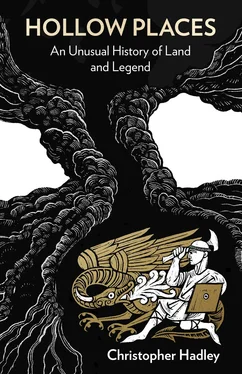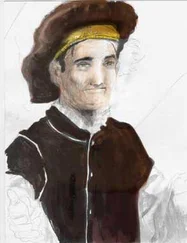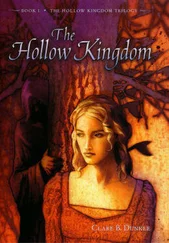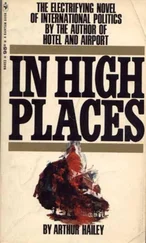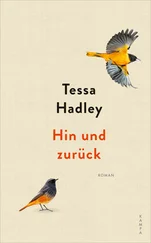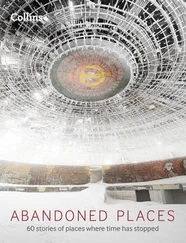Following page 450 of volume ten are six extra folio leaves. Pasted neatly in is an engraving of Shonks’ tomb, appropriated from some poor adulterated copy of the 1816 Antiquarian Itinerary . The picture is the Itinerary ’s most important contribution to the history of the legend since the text was unoriginal. Drawn by the thirty-year-old Frederick Stockdale, an antiquary more often associated with the West Country, it is captioned ‘Remains of the Tomb of O Piers Shonks, Brent Pelham Church, Herts’ . The composition is a little cramped, but mostly accurate, and captures the relief of the carvings although Stockdale chose to frame them in a rectangle, ignoring the shape of the coffin lid, and so the essential tombness is lost.
On the page facing Stockdale’s cannibalised drawing is something much more pleasing, real treasure: a unique sepia ink painting of Shonks’ tomb slab seen from directly overhead. Unusually for the prints in the Knowsley Clutterbuck, the signature and date have not been trimmed off. In the bottom left-hand corner it reads J. C. Buckler 1833 . This was John Chessell Buckler, the eldest son, notable for coming second to Charles Barry in the 1836 competition to design the new Houses of Parliament. He first came to Brent Pelham in 1831 and produced three sepia watercolours: one each of Brent Pelham Hall, Beeches and St Mary’s Church – seen from the west or tower end. His father John Buckler visited the village in 1841 and painted a more complete view of the churchyard from the south-east, revealing that the nave was without a roof. John brought with him his youngest son George, who also painted three pictures in sepia: a view of the nave and font, another picture of Brent Pelham Hall seen from the churchyard, and lastly an interior view of the chancel screen with the two-faced royal arms mounted on them. The Bucklers liked to be thorough. The art historian Robert Wark has written that they were ‘fond of documenting a building from several points of view and over a period of time, especially if new construction or changes of some kind were taking place’.
The date on the picture of the tomb, 1833, is different to the other pictures. J. C. must have returned to Brent Pelham that year expressly to document the tomb. Perhaps he feared the weather pouring into the roofless nave was taking its toll on the interior, or perhaps the light had simply not been good enough during his first visit.
Buckler’s sketch picks out the four figures around a floriated cross, the large angel above it, and the dragon below. Of the eight known illustrations of the tomb, which predate the first known photograph in 1901, J. C. Buckler’s best captures the work of the mason. He is prepared to sacrifice detail to impression. He is trying to show that this is stone, and stone of great antiquity: the smudged blank face of the angel, the wear on the other figures slowly and inexorably being smoothed back into the block of marble by the passing of time and its blows and caresses. For an architect, he is surprisingly undraughtsman-like here. It is a work of art and not just a record of the tomb at a moment in time. The art and craftsmanship of the mason inspired Buckler to create something much more than just a topographical record.
When Holbrook Jackson called grangeritis ‘a contagious and delirious mania endangering many books’, he was concerned for the hundreds of books cut up and ruined to create one vast work, such as James Gibb’s grangerised Bible, which ran to sixty vast folio volumes, ‘each so thick that he could hardly lift it from the counter’. Jackson disapproved less, if at all, when books were not destroyed but instead collectors saved pictures from ephemeral publications such as newspapers and magazines or, better still, had new pictures specially made as John Morice did.
And yet Jackson, still tongue in cheek, called it a derangement for reasons other than the desecration of books for their prints. ‘Those afflicted by the derangement,’ Jackson writes, ‘are the most flagrant of all book-defectives.’ Why? Not just because they were handy with a pair of scissors, but also because they hunted for pictures ‘of every person place and thing in any way mentioned in the text or vaguely connected with its subject matter’. The grangeriser Richard Bull epitomised this habit of wild deviation or going off at tangents: a footnote referring to Audley End in the Reverend Granger’s Biographical History of England was an excuse to add fourteen large engravings of the palace to the volume. Although Alexander Sutherland was arguably the worst afflicted grangerite of them all, transforming the six volumes of Clarendon’s History of the Rebellion into no less than sixty-one volumes in elephant folio – each nearly two feet high – with over 19,000 extra illustrations (including 743 portraits of Charles I alone).
Behind the hyperbole of Jackson’s derision I sense a secret admiration for the grangeriser. Is their crime so very bad? After all, they give us unique pictures, and in some cases the only surviving record of buildings and views and monuments. On those days when I am overwhelmed by books, by my bookshelves, and the towers of books on the kitchen table and beside my bed demanding to be read, it has occurred to me that not just readers but writers ought to grangerise existing texts rather than fuel the anxiety of book lovers by making new ones. Paste in pictures, tip in reviews, scribble in the margins, insert maps and postcards, photos and poems and train tickets, draw pictures and diagrams, and eventually unpick the book and have it rebound. What else am I doing other than unpicking the story of Piers Shonks, collating what others have thought and said, chronicling my own journey, and inserting lots of new leaves? What better way to possess a much-loved text, to make it one’s own, than to grangerise it? What did Jackson say? They hunted for pictures ‘of every person place and thing in anyway mentioned in the text or vaguely connected with its subject matter’. Guilty as charged, and not just pictures. This book stands as testament to the technique; one that at times may be clumsy, but one by which hidden truths may be revealed. Something unique, and occasionally worth keeping, emerges simply from the juxtaposition of material. Putting all those Charles I portraits together in a particular order creates something that did not exist before; the deliberate or accidental meeting of one with another may reveal something or suggest something wonderful and previously unthought-of. Like my encounter with the Field of Cloth of Gold, here was a fingerpost pointing off the main highway to the trackways and holloways. Some would lead back to the main road, others would head across country to encounter – a pleasant surprise – other byways. Some would turn out to be dead ends, but they might be where the treasure is buried. All this hints at the process by which the legend itself came together and spread; a means to understanding how the folk legend grew by steady accumulation and accretion around the tomb – both deliberate and accidental – of images and rumours, half-remembered beliefs, the common store of folklore and tale, the theories of antiquaries and, only rarely, smatterings of historical truth.
The vogue for grangerising in the late eighteenth century was partly about the reinterpretation of the written word with the pictorial. The practice came into fashion just as the relationship between visual and verbal means of communication was changing. William Blake was mixing words and pictures to create something sublime, and the first illustrated Shakespeare appeared. This points us to the importance of the tomb as both image and text: its art to captivate and inspire us; its rich imagery, in which we can read its meaning, creatively and historically. It is likely that in the same way that a picture pasted into a book altered how the book was read, so with the passing of years the imagery of the tomb altered an oral tradition about somebody called Shonks. Perhaps. But only when I had exhausted that imagery – its original meaning and what it came to represent – would I have any idea of what that oral tradition might have been. It will be what is left.
Читать дальше
